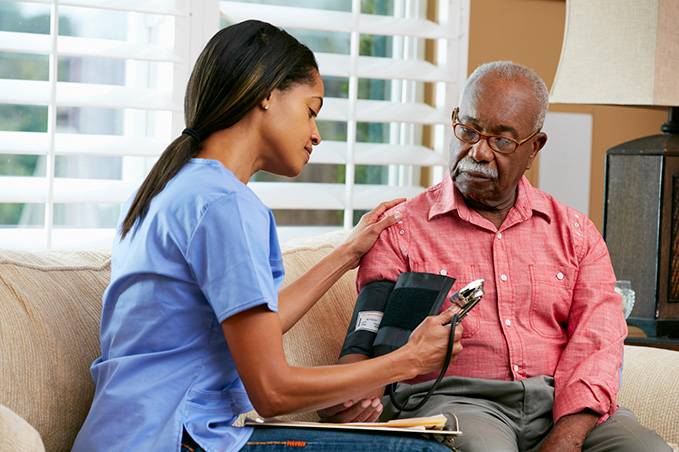Under pressure: Why it’s important to track blood pressure
 High blood pressure is a common health issue, especially as we grow older. About 75 million American adults (29%) have high blood pressure—that’s 1 in every 3 American adults.
High blood pressure is a common health issue, especially as we grow older. About 75 million American adults (29%) have high blood pressure—that’s 1 in every 3 American adults.
One of the most important things you can do to manage high blood pressure is to track it every day to measure the success off your treatment and to spot trends that may indicate complications.
What do blood pressure numbers mean?
Blood pressure is measure with two numbers:
- The first number is systolic blood pressure, which measures how much pressure your blood is exerting against artery walls when the heart beats.
- The second number is diastolic blood pressure, which shows how much pressure your blood exerts against artery walls between beats.
Different ranges of numbers indicate heart health and can serve as an indication that steps need to be taken to prevent or treat damage caused by high blood pressure.
- Less than 120/80 mm Hg - Normal
- Consistent readings of 120-129/80 mm Hg - Elevated
- Blood pressure consistently ranges from 130-139 systolic or 80-89 mm Hg diastolic - Hypertension Stage 1
- Blood pressure consistently ranges at 140/90 mm Hg or higher - Hypertension Stage 2
- Blood pressure readings exceeding 180/120 mm Hg - Hypertensive crisis (If blood pressure readings indicate a hypertensive crisis, contact your doctor immediately. If high readings are accompanied by chest pain, shortness of breath, numbness or weakness, back pain, or changes in vision or speech, call 911.)
A high systolic blood pressure (the first number) is a significant risk factor for cardiovascular disease, especially for people over 50. Systolic blood pressure typically rises steadily with age due to plaque buildup, stiffening of arteries and cardiac and vascular disease. However, high readings of either number may indicate high blood pressure. The risk of death from ischemic heart disease and stroke doubles with every 20 mm Hg systolic or 10 mm Hg diastolic increase among people from age 40 to 89.
Monitoring blood pressure at home
People who have been diagnosed with high blood pressure or who are at risk for high blood pressure will find it beneficial to check their blood pressure regularly to spot trends and changes in their readings. If you have elevated blood pressure or a condition that constributes to high blood pressure, such as diabetes or kidney problems, home blood pressure monitoring should be part of your daily routine.
Checking and tracking your blood pressure at home can mean an earlier high blood pressure diagnosis and more effective treatment.
Some people have irregular readings in a doctor's office because of stress. Consistent home readings can give a better picture of heart health.
Home checks can also help detect improvements due to medications and healthier habits. Patients who check their blood pressure at home keep it at the top of mind, which helps them make healthier decisions every day.
Ask if your health insurance covers the cost of a home blood pressure monitor.
Tips for accurate blood pressure readings
There are many different types of blood pressure monitors available. Your doctor may be able to recommend a system that will work best for you and your needs and schedule and help you test its accuracy during an office visit.
Whatever kind of monitor you use, consistency is key to gaining useful results.
Most patients are advised to take their blood pressure twice a day. The first check should be in the morning before eating or taking any medications, but not immediately after waking up. The second should be in the evening, at least 30 minutes after your last meal of the day.
For accurate, meaningful readings:
- Take two or three readings at each check for more accurate results.
- Avoid food, caffeine, tobacco and alcohol for 30 minutes before taking a measurement.
- Sit quietly and calmly before and during monitoring.
- Use the same arm each time, resting it level with your heart on a table or chair arm.
- Place the cuff on bare skin.
- Record each reading in a designated notebook or chart or in your electronic personal health record.
Your doctor will recommend a monitoring regimen based on your current treatment and appointment schedule. If you have any unusual or persistent increases in your blood pressure, talk to your doctor.
High blood pressure and home health care
The need for ongoing testing and care shouldn’t prevent you or a loved one from staying in their own home.
The Belvedere Home Care staff is trained to provide a wide range of everyday care, testing and monitoring to track your loved one’s health and making sure they are staying on schedule with medications and sticking to their prescribed diet. This allows them to stay in their home and be comfortable in a familiar setting when they need only brief daily visits to fulfill their health needs.
We work with each patient’s healthcare team to provide a seamless continuum of care.
Our nurses and aides can provide monitoring services including:
- Monitor blood pressure and other vital signs
- Glucose testing
- Manage medication and talk to doctors or pharmacists
- Provide education to clients and families
If you or a loved one have high blood pressure and could benefit from ongoing professional monitoring and care, contact us today at (518) 694-9400 Option 4 or info@belvedereservices.com.

